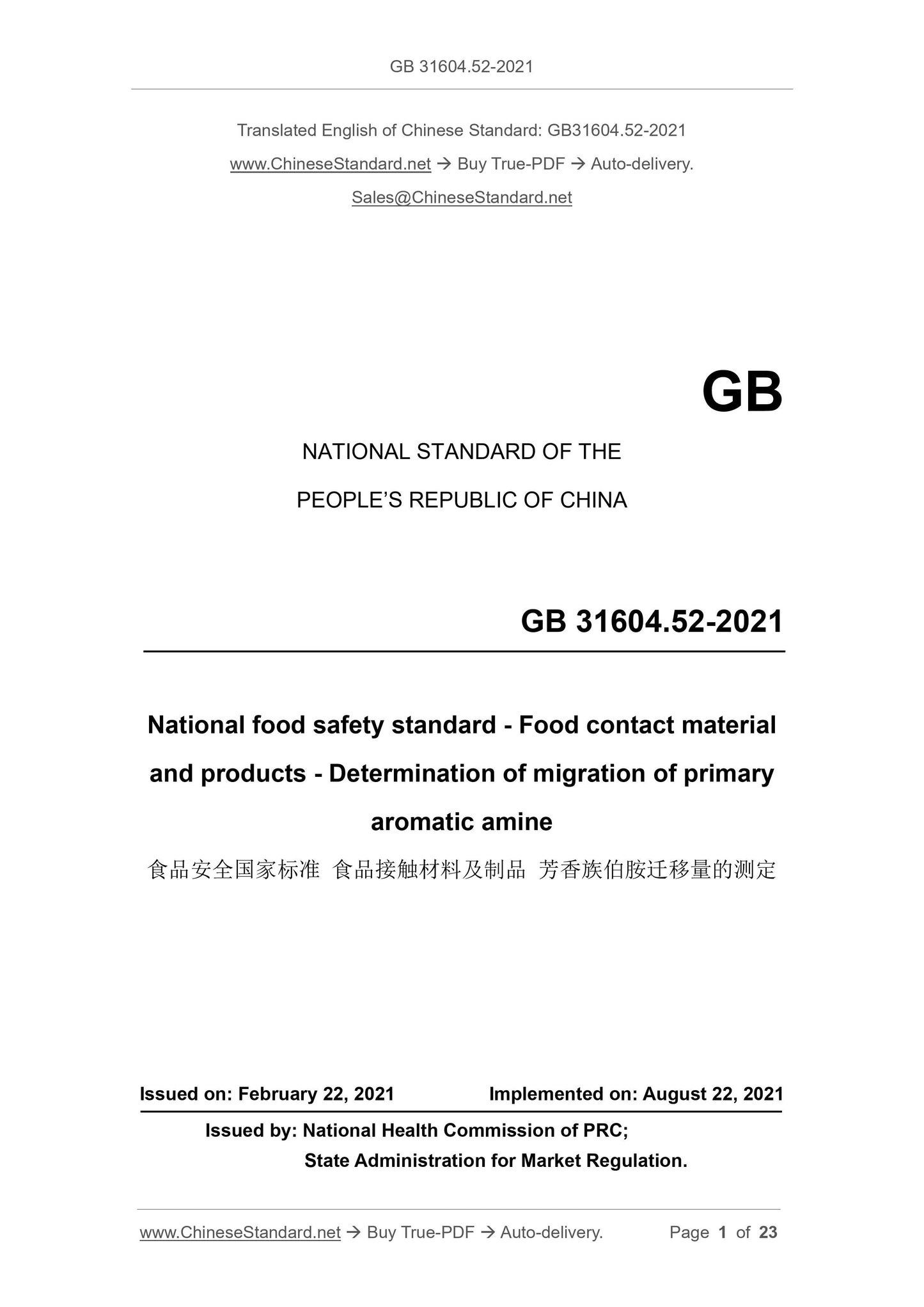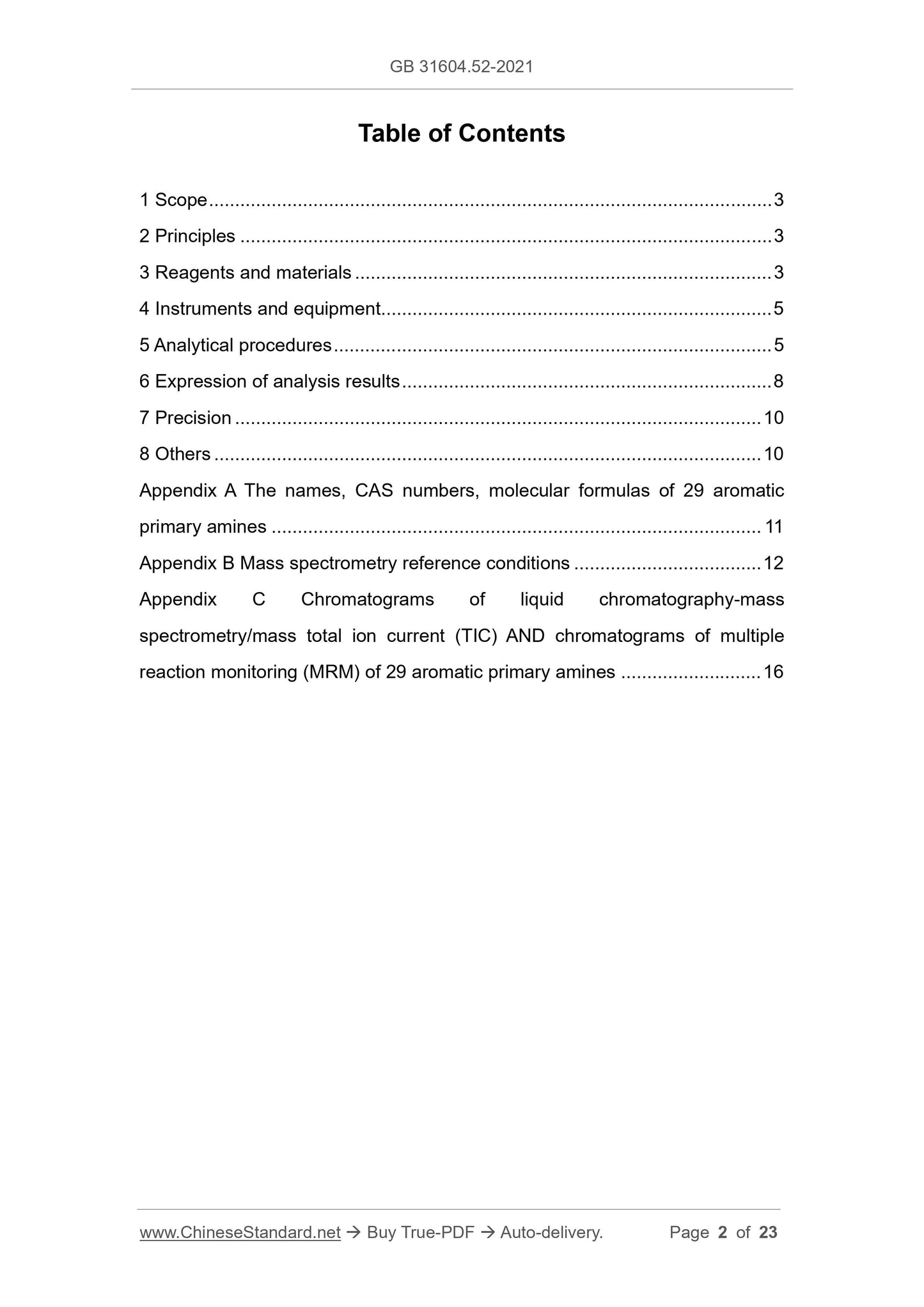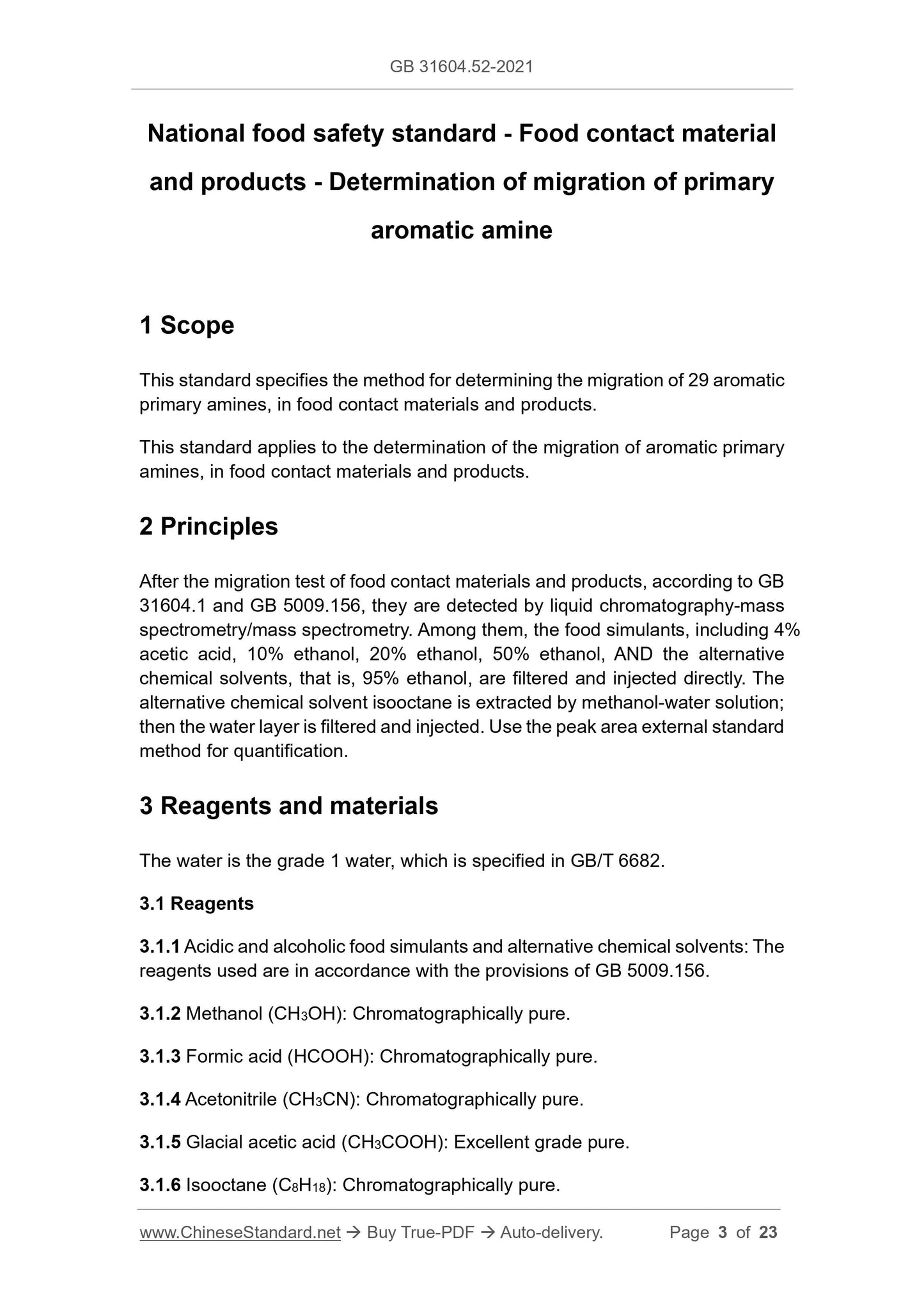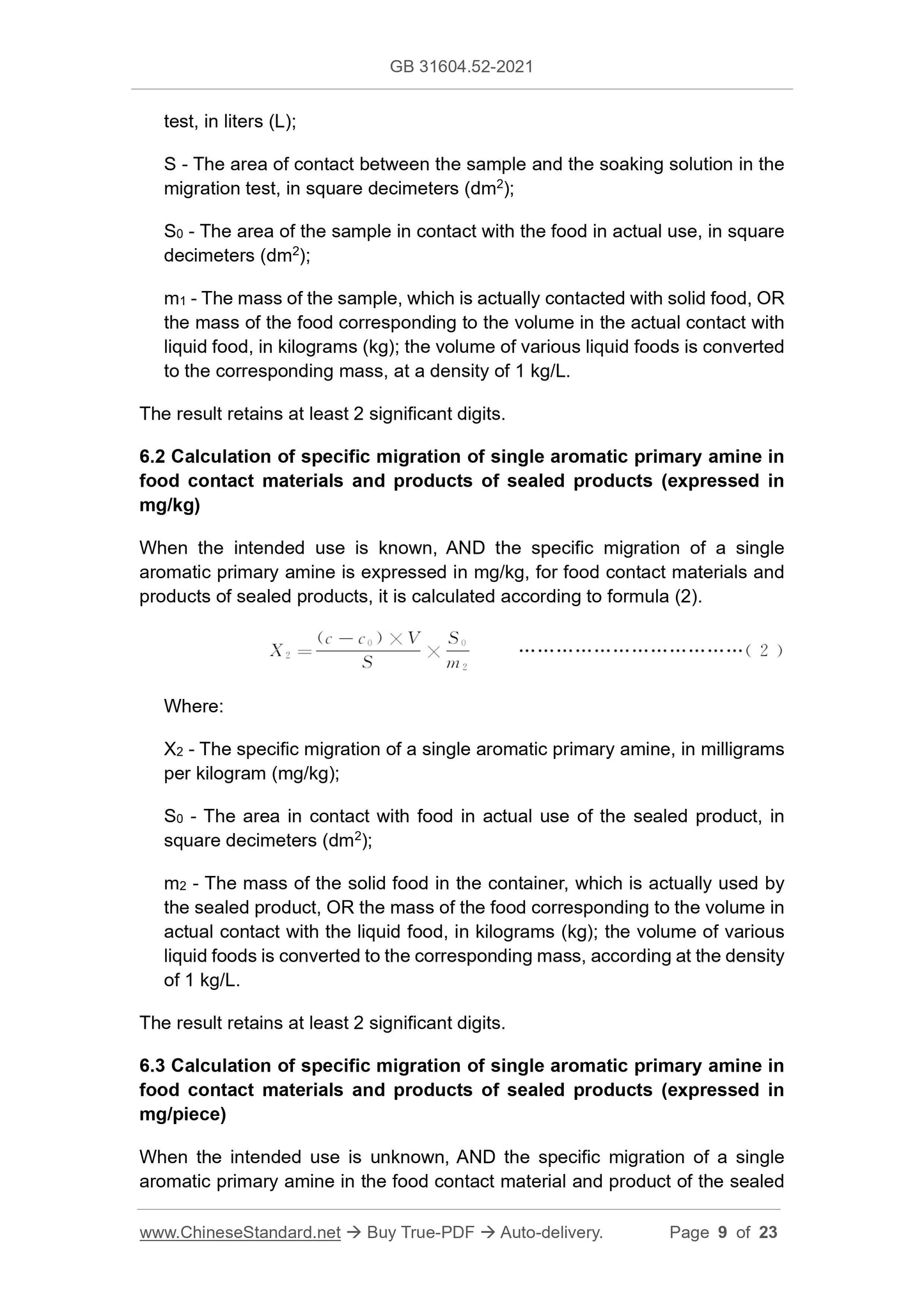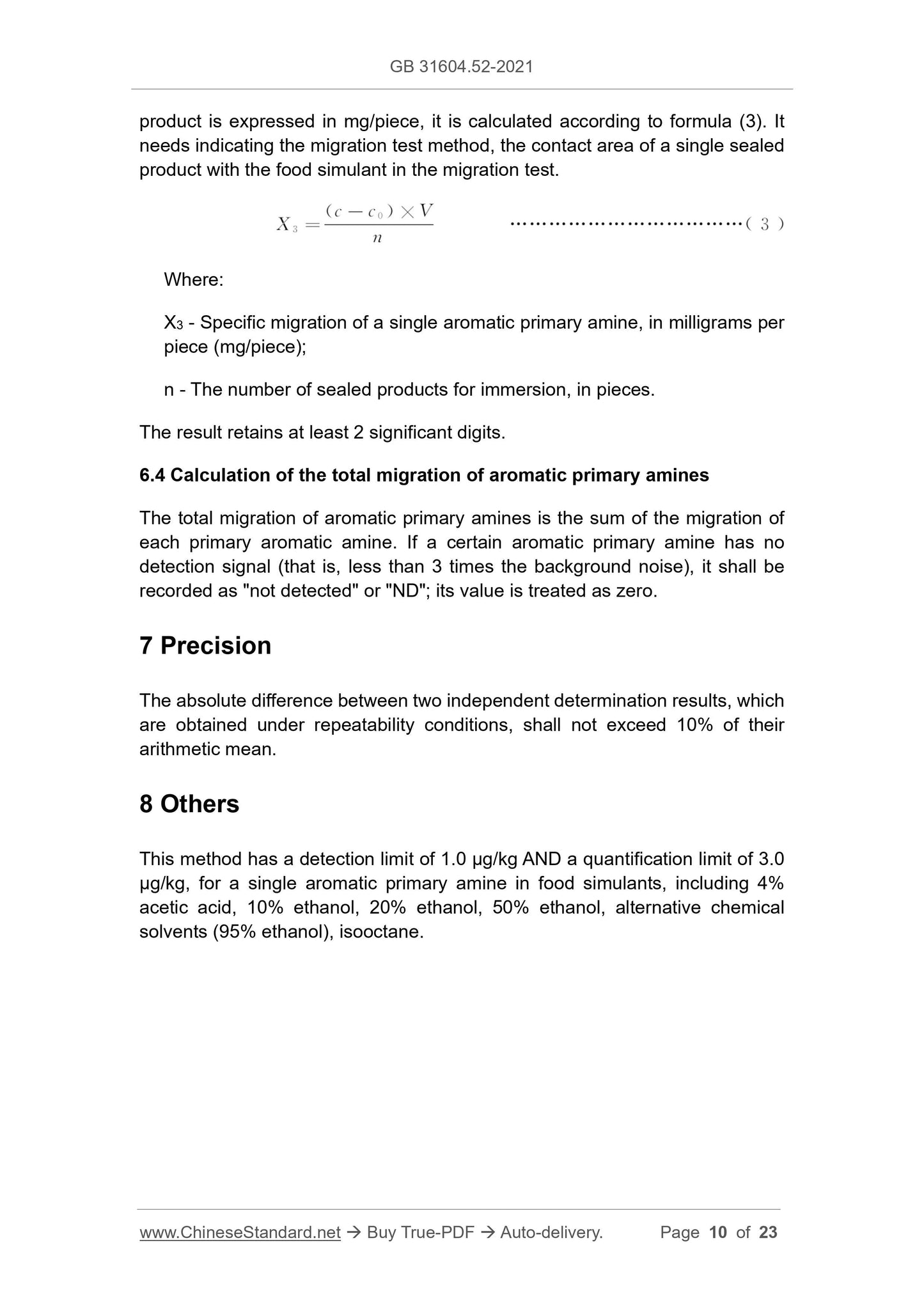1
/
of
6
PayPal, credit cards. Download editable-PDF & invoice in 1 second!
GB 31604.52-2021 English PDF (GB31604.52-2021)
GB 31604.52-2021 English PDF (GB31604.52-2021)
Regular price
$260.00 USD
Regular price
Sale price
$260.00 USD
Unit price
/
per
Shipping calculated at checkout.
Couldn't load pickup availability
Delivery: 3 seconds. Download true-PDF + Invoice.
Get QUOTATION in 1-minute: Click GB 31604.52-2021
Historical versions: GB 31604.52-2021
Preview True-PDF (Reload/Scroll if blank)
GB 31604.52-2021: National food safety standard - Food-contact materials and articles - Determination of migration of primary aromatic amine
GB 31604.52-2021
GB
NATIONAL STANDARD OF THE
PEOPLE’S REPUBLIC OF CHINA
National food safety standard - Food contact material
and products - Determination of migration of primary
aromatic amine
ISSUED ON: FEBRUARY 22, 2021
IMPLEMENTED ON: AUGUST 22, 2021
Issued by: National Health Commission of PRC;
State Administration for Market Regulation.
Table of Contents
1 Scope ... 3
2 Principles ... 3
3 Reagents and materials ... 3
4 Instruments and equipment... 5
5 Analytical procedures ... 5
6 Expression of analysis results ... 8
7 Precision ... 10
8 Others ... 10
Appendix A The names, CAS numbers, molecular formulas of 29 aromatic
primary amines ... 11
Appendix B Mass spectrometry reference conditions ... 12
Appendix C Chromatograms of liquid chromatography-mass
spectrometry/mass total ion current (TIC) AND chromatograms of multiple
reaction monitoring (MRM) of 29 aromatic primary amines ... 16
National food safety standard - Food contact material
and products - Determination of migration of primary
aromatic amine
1 Scope
This standard specifies the method for determining the migration of 29 aromatic
primary amines, in food contact materials and products.
This standard applies to the determination of the migration of aromatic primary
amines, in food contact materials and products.
2 Principles
After the migration test of food contact materials and products, according to GB
31604.1 and GB 5009.156, they are detected by liquid chromatography-mass
spectrometry/mass spectrometry. Among them, the food simulants, including 4%
acetic acid, 10% ethanol, 20% ethanol, 50% ethanol, AND the alternative
chemical solvents, that is, 95% ethanol, are filtered and injected directly. The
alternative chemical solvent isooctane is extracted by methanol-water solution;
then the water layer is filtered and injected. Use the peak area external standard
method for quantification.
3 Reagents and materials
The water is the grade 1 water, which is specified in GB/T 6682.
3.1 Reagents
3.1.1 Acidic and alcoholic food simulants and alternative chemical solvents: The
reagents used are in accordance with the provisions of GB 5009.156.
3.1.2 Methanol (CH3OH): Chromatographically pure.
3.1.3 Formic acid (HCOOH): Chromatographically pure.
3.1.4 Acetonitrile (CH3CN): Chromatographically pure.
3.1.5 Glacial acetic acid (CH3COOH): Excellent grade pure.
3.1.6 Isooctane (C8H18): Chromatographically pure.
of isooctane standard working solution into a test tube. Add 2 mL of methanol-
water extract (3.2.3). Shake it for 30 s. Let it stand for stratification. Take the
lower layer of aqueous solution. Use a nylon filter to filter it, to prepare for
determination.
3.4.4.2 Standard working solutions for other food simulants and
alternative chemical solvents
Accurately pipette 30 µL, 50 µL, 100 µL, 300 µL, 500 µL of the standard
intermediate solution A (3.4.2) of aromatic primary amine, in a 10 mL volumetric
flask. Use 10% ethanol to make its volume reach to the mark, to obtain the
standard working solution, which has an aromatic primary amine concentration
of 3.0 µg/L, 5.0 µg/L, 10.0 µg/L, 30.0 µg/L, 50.0 µg/L, respectively. In the same
way, use the 4% acetic acid, 20% ethanol, 50% ethanol food simulant,
alternative chemical solvent (95% ethanol), to prepare the standard working
solutions of the aromatic primary amine, in the same concentration series.
4 Instruments and equipment
4.1 Liquid chromatography tandem mass spectrometer: Electrospray ion
source (ESI)
4.2 Analytical balance: Sensitivity is 0.0001 g.
4.3 Micro syringe: 10 µL, 100 µL, 1000 µL.
4.4 Constant temperature drying oven or constant temperature water bath
device.
4.5 Vortex mixer.
4.6 Needle type nylon filter: Pore size 0.22 µm.
5 Analytical procedures
5.1 Preparation of food simulants
5.1.1 General
The migration test of this standard uses 4% acetic acid, 10% ethanol, 20%
ethanol, 50% ethanol food simulants, alternative chemical solvent (95%
ethanol), isooctane. Vegetable oil is not suitable for the determination of the
migration of aromatic primary amines.
5.1.2 Migration test
test, in liters (L);
S - The area of contact between the sample and the soaking solution in the
migration test, in square decimeters (dm2);
S0 - The area of the sample in contact with the food in actual use, in square
decimeters (dm2);
m1 - The mass of the sample, which is actually contacted with solid food, OR
the mass of the food corresponding to the volume in the actual contact with
liquid food, in kilograms (kg); the volume of various liquid foods is converted
to the corresponding mass, at a density of 1 kg/L.
The result retains at least 2 significant digits.
6.2 Calculation of specific migration of single aromatic primary amine in
food contact materials and products of sealed products (expressed in
mg/kg)
When the intended use is known, AND the specific migration of a single
aromatic primary amine is expressed in mg/kg, for food contact materials and
products of sealed products, it is calculated according to formula (2).
Where:
X2 - The specific migration of a single aromatic primary amine, in milligrams
per kilogram (mg/kg);
S0 - The area in contact with food in actual use of the sealed product, in
square decimeters (dm2);
m2 - The mass of the solid food in the container, which is actually used by
the sealed product, OR the mass of the food corresponding to the volume in
actual contact with the liquid food, in kilograms (kg); the volume of various
liquid foods is converted to the corresponding mass, according at the density
of 1 kg/L.
The result retains at least 2 significant digits.
6.3 Calculation of specific migration of single aromatic primary amine in
food contact materials and products of sealed products (expressed in
mg/piece)
When the intended use is unknown, AND the specific migration of a single
aromatic primary amine in the food contact material and product of the sealed
product is expressed in mg/piece, it is calculated according to formula (3). It
needs indicating the migration test method, the contact area of a single sealed
product with the food simulant in the migration test.
Where:
X3 - Specific migration of a single aromatic primary amine, in milligrams per
piece (mg/piece);
n - The number of sealed products for immersion, in pieces.
The result retains at least 2 significant digits.
6.4 Calculation of the total migration of aromatic primary amines
The total migration of aromatic primary amines is the sum of the migration of
each primary aromatic amine. If a certain aromatic primary amine has no
detection signal (that is, less than 3 times the background noise), it shall be
recorded as "not detected" or "ND"; its value is treated as zero.
7 Precision
The absolute difference between two independent determination results, which
are obtained under repeatability conditions, shall not exceed 10% of their
arithmetic mean.
8 Others
This method has a detection limit of 1.0 µg/kg AND a quantification limit of 3.0
µg/kg, for a single aromatic primary amine in food simulants, including 4%
acetic acid, 10% ethanol, 20% ethanol, 50% ethanol, alternative chemical
solvents (95% ethanol), isooctane.
Get QUOTATION in 1-minute: Click GB 31604.52-2021
Historical versions: GB 31604.52-2021
Preview True-PDF (Reload/Scroll if blank)
GB 31604.52-2021: National food safety standard - Food-contact materials and articles - Determination of migration of primary aromatic amine
GB 31604.52-2021
GB
NATIONAL STANDARD OF THE
PEOPLE’S REPUBLIC OF CHINA
National food safety standard - Food contact material
and products - Determination of migration of primary
aromatic amine
ISSUED ON: FEBRUARY 22, 2021
IMPLEMENTED ON: AUGUST 22, 2021
Issued by: National Health Commission of PRC;
State Administration for Market Regulation.
Table of Contents
1 Scope ... 3
2 Principles ... 3
3 Reagents and materials ... 3
4 Instruments and equipment... 5
5 Analytical procedures ... 5
6 Expression of analysis results ... 8
7 Precision ... 10
8 Others ... 10
Appendix A The names, CAS numbers, molecular formulas of 29 aromatic
primary amines ... 11
Appendix B Mass spectrometry reference conditions ... 12
Appendix C Chromatograms of liquid chromatography-mass
spectrometry/mass total ion current (TIC) AND chromatograms of multiple
reaction monitoring (MRM) of 29 aromatic primary amines ... 16
National food safety standard - Food contact material
and products - Determination of migration of primary
aromatic amine
1 Scope
This standard specifies the method for determining the migration of 29 aromatic
primary amines, in food contact materials and products.
This standard applies to the determination of the migration of aromatic primary
amines, in food contact materials and products.
2 Principles
After the migration test of food contact materials and products, according to GB
31604.1 and GB 5009.156, they are detected by liquid chromatography-mass
spectrometry/mass spectrometry. Among them, the food simulants, including 4%
acetic acid, 10% ethanol, 20% ethanol, 50% ethanol, AND the alternative
chemical solvents, that is, 95% ethanol, are filtered and injected directly. The
alternative chemical solvent isooctane is extracted by methanol-water solution;
then the water layer is filtered and injected. Use the peak area external standard
method for quantification.
3 Reagents and materials
The water is the grade 1 water, which is specified in GB/T 6682.
3.1 Reagents
3.1.1 Acidic and alcoholic food simulants and alternative chemical solvents: The
reagents used are in accordance with the provisions of GB 5009.156.
3.1.2 Methanol (CH3OH): Chromatographically pure.
3.1.3 Formic acid (HCOOH): Chromatographically pure.
3.1.4 Acetonitrile (CH3CN): Chromatographically pure.
3.1.5 Glacial acetic acid (CH3COOH): Excellent grade pure.
3.1.6 Isooctane (C8H18): Chromatographically pure.
of isooctane standard working solution into a test tube. Add 2 mL of methanol-
water extract (3.2.3). Shake it for 30 s. Let it stand for stratification. Take the
lower layer of aqueous solution. Use a nylon filter to filter it, to prepare for
determination.
3.4.4.2 Standard working solutions for other food simulants and
alternative chemical solvents
Accurately pipette 30 µL, 50 µL, 100 µL, 300 µL, 500 µL of the standard
intermediate solution A (3.4.2) of aromatic primary amine, in a 10 mL volumetric
flask. Use 10% ethanol to make its volume reach to the mark, to obtain the
standard working solution, which has an aromatic primary amine concentration
of 3.0 µg/L, 5.0 µg/L, 10.0 µg/L, 30.0 µg/L, 50.0 µg/L, respectively. In the same
way, use the 4% acetic acid, 20% ethanol, 50% ethanol food simulant,
alternative chemical solvent (95% ethanol), to prepare the standard working
solutions of the aromatic primary amine, in the same concentration series.
4 Instruments and equipment
4.1 Liquid chromatography tandem mass spectrometer: Electrospray ion
source (ESI)
4.2 Analytical balance: Sensitivity is 0.0001 g.
4.3 Micro syringe: 10 µL, 100 µL, 1000 µL.
4.4 Constant temperature drying oven or constant temperature water bath
device.
4.5 Vortex mixer.
4.6 Needle type nylon filter: Pore size 0.22 µm.
5 Analytical procedures
5.1 Preparation of food simulants
5.1.1 General
The migration test of this standard uses 4% acetic acid, 10% ethanol, 20%
ethanol, 50% ethanol food simulants, alternative chemical solvent (95%
ethanol), isooctane. Vegetable oil is not suitable for the determination of the
migration of aromatic primary amines.
5.1.2 Migration test
test, in liters (L);
S - The area of contact between the sample and the soaking solution in the
migration test, in square decimeters (dm2);
S0 - The area of the sample in contact with the food in actual use, in square
decimeters (dm2);
m1 - The mass of the sample, which is actually contacted with solid food, OR
the mass of the food corresponding to the volume in the actual contact with
liquid food, in kilograms (kg); the volume of various liquid foods is converted
to the corresponding mass, at a density of 1 kg/L.
The result retains at least 2 significant digits.
6.2 Calculation of specific migration of single aromatic primary amine in
food contact materials and products of sealed products (expressed in
mg/kg)
When the intended use is known, AND the specific migration of a single
aromatic primary amine is expressed in mg/kg, for food contact materials and
products of sealed products, it is calculated according to formula (2).
Where:
X2 - The specific migration of a single aromatic primary amine, in milligrams
per kilogram (mg/kg);
S0 - The area in contact with food in actual use of the sealed product, in
square decimeters (dm2);
m2 - The mass of the solid food in the container, which is actually used by
the sealed product, OR the mass of the food corresponding to the volume in
actual contact with the liquid food, in kilograms (kg); the volume of various
liquid foods is converted to the corresponding mass, according at the density
of 1 kg/L.
The result retains at least 2 significant digits.
6.3 Calculation of specific migration of single aromatic primary amine in
food contact materials and products of sealed products (expressed in
mg/piece)
When the intended use is unknown, AND the specific migration of a single
aromatic primary amine in the food contact material and product of the sealed
product is expressed in mg/piece, it is calculated according to formula (3). It
needs indicating the migration test method, the contact area of a single sealed
product with the food simulant in the migration test.
Where:
X3 - Specific migration of a single aromatic primary amine, in milligrams per
piece (mg/piece);
n - The number of sealed products for immersion, in pieces.
The result retains at least 2 significant digits.
6.4 Calculation of the total migration of aromatic primary amines
The total migration of aromatic primary amines is the sum of the migration of
each primary aromatic amine. If a certain aromatic primary amine has no
detection signal (that is, less than 3 times the background noise), it shall be
recorded as "not detected" or "ND"; its value is treated as zero.
7 Precision
The absolute difference between two independent determination results, which
are obtained under repeatability conditions, shall not exceed 10% of their
arithmetic mean.
8 Others
This method has a detection limit of 1.0 µg/kg AND a quantification limit of 3.0
µg/kg, for a single aromatic primary amine in food simulants, including 4%
acetic acid, 10% ethanol, 20% ethanol, 50% ethanol, alternative chemical
solvents (95% ethanol), isooctane.
Share
